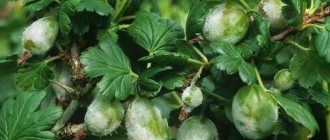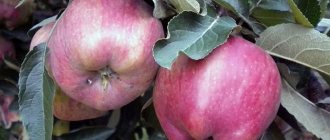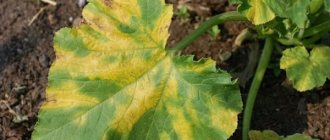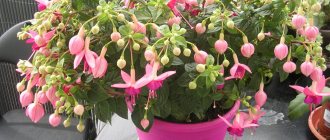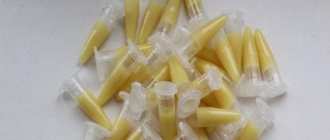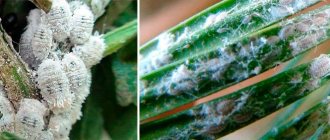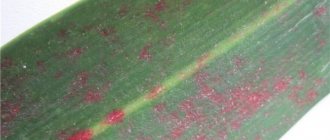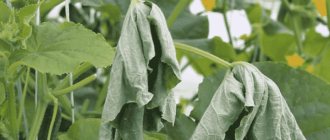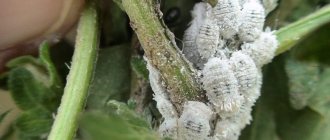Powdery mildew - what is it?
White plaque is a fungal disease called powdery mildew. Powdery mildew on indoor plants is a coating of fungal spores. After the defeat, the plant soon becomes lethargic, the leaves dry out, and the flower buds fall off. This happens because the fungus sucks out all the useful and vital substances from the plant.
The main cause of the disease is humid air, incorrect temperature, drafts and overwatering of the soil.
This type of disease is contagious and can be easily confused with another disease. If white plaque is detected, treatment should be started immediately. If treated incorrectly or untimely, unfortunately, the plant dies.
Fungus on leaves
Preventive measures
The well-known rule - a disease is easier to prevent than to cure - applies to all living things, including indoor flowers. In order not to miss the moment of infection, it is enough to follow simple measures:
- regular inspections of plants for stains and pests
- cleaning leaves from dust
- pruning, removing old leaves in contact with the ground
- creating optimal conditions for each species, taking into account lighting, humidity, temperature and feeding
The gardener's constant attention to his pets, his compliance with agricultural technology and living conditions, as well as first aid if necessary - these are the main components of the health and well-groomed appearance of indoor plants.
Video about ways to combat powdery mildew:
Unfortunately, indoor plants can also get sick. All plants, if not maintained correctly, are susceptible to various pests and diseases. One of the most common ailments is a white coating that affects leaves, flowers and even the soil.
Diseased leaves
Cause of powdery mildew
The fungus lives in almost every indoor plant, but it does not always manifest itself and begin to destroy the plants. When the plant is provided with timely watering and proper care, mealy fungi have no chance. Fungi parasitize and reproduce in the following cases:
- If it's cool outside, about 12 - 15 degrees, rainy season, high humidity. Outdoor conditions do not affect indoor plants as much as they do on plants located on the balcony. Therefore, in bad weather, balcony plants should be moved to a warmer place.
- If the soil is oversaturated with nitrogen
- Lots of vegetation in the pot and little space
- Improper care, not timely watering. If the plant is often watered and the earthen lump does not have time to dry out, or vice versa, the earth constantly dries out, and then it is watered abundantly
Since this disease is portable, it is very easy to infect other plants:
- If you touched a diseased plant, then touch a healthy one
- If mealy fungi get into the irrigation water
- Even when airborne, spores can infect neighboring plants.
Avoid contact with fungus
We create the right care
To get rid of white plaque, it is necessary to provide comprehensive care for the diseased plant. First you need to understand the agricultural technology of cultivation:
- Water the plant only when the top layer of soil begins to dry out.
- When treating a plant, you cannot spray it (with the exception of medicinal purposes). This also applies to healthy plants for preventive purposes.
- The flower needs more sunny days, it is advisable to move the flower to a dry and warm place, with little direct sunlight
- Withered and dry leaves and buds must be torn off
- With this disease, you cannot use any fertilizers or fertilizers.
Hide the plant from direct sunlight
Provide the plant with proper care, otherwise powdery mildew will become your regular visitor. Now let's move on to treating the disease.
Treatment of white plaque
To get rid of white plaque forever, it is necessary to provide the plant with proper treatment:
- If powdery mildew appears on bushy flowers, such as house roses, various types of chrysanthemums, and petunias, you need to prune the plant generously, ridding it of diseased leaves and flowers. The more leaves and twigs you remove, the greater the chance of recovery for your plant.
- It is advisable to arrange a flower transplant; it is necessary to transplant the plant into fresh soil
- Specialized flower shops sell various additives that fight fungi. The plant needs to be sprayed generously and wiped with each leaf.
We leave only healthy leaves and stems
Step-by-step instructions on how to fight with home remedies and chemicals
Let's look at how to get rid of the white coating that affects the plant on home orchids. Treatment for a flower depends on the exact cause of the appearance of plaque on the leaves or other parts of the plant. When infested with powdery mildew or mealybugs, different treatment measures are required.
But the required general steps are:
- isolation of the infected orchid from other plants;
- remove all damaged parts (leaves, buds), cover the cut areas with crushed activated carbon;
- Only after removing the infected leaves can treatment begin.
How to treat powdery mildew infection?
You need to remove the top soil layer and pour new soil into the pot. It is advisable to take a special soil substrate, rather than ordinary soil from the garden bed. New soil should be sprinkled with ash on top (thickness up to 2 cm). What actions to take next?
- If the infection is not severe, you can prepare safe homemade decoctions. You can take horsetail grass (100 g per 1 liter of water), garlic (50 g crushed cloves per 2 liters of water), onion peels (200 g per 10 liters of water). Be sure to boil and insist. Before processing, dilute with water. Spray through a spray bottle.
- In case of mass damage, treatment with chemicals is indicated. These are copper-containing fungicides or antifungals. Colloidal sulfur or Fitosporin are suitable. Look for dosage on the packaging.
- Disinfecting the place where the pot stood with an antiseptic. The goal is to kill the remaining spores.
What to do if a mealybug appears?
Collect all insects from the plant by hand, wipe the leaves with diluted alcohol or soapy water (water and laundry or tar soap).
If you see too many insects, chemical help is required.
- You need to take insecticides. These are Aktara, Aktellik, Mospilan, Fitoverm. Follow the dosage for home flowers. Carry out processing with protective gloves.
- Next, place the orchid in a bag, spray the plant and tie the bag for 2-2.5 hours.
- After the expiration date, remove the orchid and wash with soapy water.
- Repeat the treatment 3-4 times, the time interval between procedures is 10-14 days.
Mandatory additional actions include disinfecting the soil in the pot and the place where the pot stood with an antiseptic. You also need to carefully examine the neighbors of the infected orchid, or better yet, send all neighboring flowers to quarantine for 14 days.
From the video you will learn how to treat an orchid from mealybug:
Also, sometimes orchids turn yellow, blacken, their roots change color, and their leaves crack. You can read about these problems on our website.
Treatment with chemicals
The easiest way to cure a houseplant is with chemicals. They actively stop the growth of fungi, having a detrimental effect on it. And the plant is helped in the form of protection and treatment.
There are a lot of chemicals today, some of them are: Topaz, Previkur, Fundazol and many others.
Chemicals
Folk remedies against powdery mildew
Please note that folk remedies cannot cure the advanced stage of the disease. Such measures are carried out as prophylaxis or to treat the initial stages of the disease:
- For one liter of hot boiled water, take one tablespoon of baking soda and one teaspoon of liquid soap. without additives. The plant must be sprayed once a day for three days. The water must be cooled before use.
Soda + soap
- You need to add a few crystals of potassium permanganate per liter of water; the result should be a barely noticeable pink tint. The plant must be sprayed once a day at intervals of three days.
Potassium permanganate solution
- For one liter of hot water you need to take half a teaspoon of mustard powder. After cooling, the plant can be sprayed and watered with the resulting solution.
- This method is the most effective for treating fungal infections on indoor plants. Take five grams of copper sulfate per glass of water. Dissolve a small piece of soap in a separate container. After preparation, you need to pour the soap mass into copper sulfate. It is necessary to pour in a thin stream with constant stirring.
Soap + copper sulfate
- Three cloves of garlic must be chopped and poured with hot water, about one liter. After a day of infusion, it is necessary to remove the remaining garlic and water the flower with the resulting garlic water.
With the right approach to treatment, as well as timely measures, it is possible to defeat powdery mildew and cure your favorite plant.
Pay attention to the video on the topic:
Leaf hygiene
The impeccable appearance of a plant indicates, first of all, that it is healthy. But sometimes even a healthy plant looks untidy, and the reason for this may be dust settled on the leaves.
Any housewife knows how quickly dust accumulates in a room, so regular cleaning is a routine but necessary procedure. Dust settled on the leaves of plants, when water gets on them, turns into dirt, which must also be removed regularly: dust and dirt interfere with the process of photosynthesis and evaporation of moisture, attract pests and create favorable conditions for the development of diseases .
Procedure for cleaning leaves:
- wipe the leaf plates once or twice a week with a soft material - a damp cloth or sponge;
- You need to remove dust from both the top and bottom sides of the leaves;
- Carry out the procedure in the morning or afternoon so that the leaves have time to dry by evening;
- very dusty or dirty leaves can be washed with soapy water, which should then be rinsed off with clean water. If you use alkali to wash the leaves, cover the substrate with film.
Leaves covered with fluff or lint are not washed, but are cleaned of dust with a brush with soft, thick bristles.
Using a vitamin cocktail
You can improve your orchid’s health by spraying the leaves with a vitamin cocktail. It is prepared from a mixture of vitamins :
- IN 1;
- AT 6;
- B12 (one ampoule of each);
- Dissolved in 1 liter of water.
It is enough to spray the orchid leaves once or twice a month with this composition
Indoor air humidity
Sometimes the tips of the leaves dry out, and dark brown spots form on the leaf blades. The reason for this is that the air in the room is too dry, and many decorative foliage plants require high humidity. What can be done to prevent the leaves from losing their attractiveness? Here are some ways to make dry air more humid:
- Small containers with water are placed between the plants, which, evaporating, saturates the air with moisture;
- pots with plants are placed on pallets with wet expanded clay or pebbles;
- the leaves are regularly wiped with a damp sponge and from time to time the moisture-loving plants are washed in the shower;
- in winter, when the air in the room is dried out by the heating operating at full power, barely wrung out wet towels are thrown over the radiators;
- The easiest way to increase the humidity level in a room is with a household electric humidifier.
Shower for ficus
Ficus is a living organism, and it also loves to swim. But if large-leaved ficus can still be dealt with manually, then plants with small leaves (ficus Benjamin, fern, dracaena, etc.) are much more difficult to clean. A shower, which many houseplants love, will help here.
When arranging a bath for your green friends, you need to protect the soil from washing out (with film or cloth), monitor the water pressure, which should be very small, and its temperature – no more than 30 degrees. If the ficus is very dirty, then you can use a weak solution of shampoo or baby soap, only after cleansing you need to thoroughly rinse them off the leaves.
A clean and healthy plant is the best decoration for your home interior. We hope that the little tricks you can use to wipe your ficus to make the leaves shine will be useful to you in practice.
Traditional methods
The principle of operation of home control methods is that plants are treated with emulsions, tinctures and substances that are supposed to remove shield aphids. Some of them have questionable effects, because sometimes they do more harm than good. After processing with onions, garlic, kerosene and alcohol, a burn is quite possible.
Oil emulsions and other similar substances form a film on the leaves that blocks the access of oxygen. At the same time, plants stop “breathing,” and photosynthesis, which they need to produce organic substances that promote growth and development, stops. Scale insects, as a rule, settle under the leaf where the stomata are located.
Soap-based solutions and tobacco tincture have shown positive results in combination with mechanical removal. Accordingly, they need to be used many times. The soap solution also forms an impermeable film on the leaves, so it must be washed off after 24 hours.
The most common folk mixtures:
- Baby soap : 1 liter of water, 1.5 tsp. grated cosmetic product. The solution is applied to large-leaved plants using a sponge, cotton wool or cloth. Stand for 15 minutes. And it is washed off with a shower (the ground must be protected from water).
- Kerosene-soap mixture : 10 g of kerosene, 50 g of laundry soap, 2 crystals of manganese. Apply the solution to places where insects accumulate with a cotton swab, cloth or brush. Leave for 30 minutes, rinse.
- Hot pepper infusion : 4 medium chilies, 500 ml water. Cut the pods, boil for 20 minutes, cool, strain, spray. Each time the broth is prepared fresh.
- Garlic (onion) infusion : 5 cloves of garlic or 1 medium onion. Chop the vegetables and add 150 ml of water. Leave for at least 5 hours, add 1 tsp. grated soap, apply using a sprayer.
- Infusion of walnut leaves : take 300 g of crushed raw materials, 1 liter of boiling water. Leave for 24 hours, treat the leaf blades of the plant on both sides after preliminary washing with soap, leave for 24 hours and rinse. For a stronger effect, you can add another 150 g of tobacco leaves to the tincture.
- Soap and alcohol solution : mix 1 liter of water, 10 ml of ethylene, 15 g of soap. Use carefully on plants with soft or thin leaves, as they are extremely sensitive to alcohol. The resulting mixture is applied with a brush first to one leaf and left for about a day. Only after a successful reaction to this test can further processing of the entire plant be carried out carefully.
This is interesting: Teasel - growing and caring for a pile cone in the garden in open ground
Olive oil
You can wipe the leaves with olive oil. It is necessary to apply it to a cloth or sponge and treat the plate from base to tip. Excess must be removed by blotting the leaves with a dry and clean napkin.
Before using the oil, you need to take into account that it will create a film on the surface of the plant, due to which the flower may stop absorbing moisture. In addition, this will make it difficult for oxygen to reach the leaves, which will affect development.
Milk
Milk is also used to add shine - you need to make a mixture by combining the drink in equal parts with water. After this, the resulting liquid is applied to a sponge and the leaves are wiped with it. The shine is not strong, but noticeable.
The solution may leave a film on some plates, as is the case with olive oil. Therefore, it is recommended to increase the amount of water, and, on the contrary, reduce the volume of milk. Then you will get a lighter product that will be safe for the flower.
If a solution with a lower concentration of milk is used, the shine will also be reduced. However, it can be neglected so that the development of pets does not stop for the sake of aesthetic appeal alone.
Beer
It is recommended to use beer for large plates. In addition, it is better to take a product with a short shelf life. For the solution you need to prepare 1 part beer and 1 part water, apply it to a sponge and wipe the surface. It will become smooth and dark green.
It should be noted that in the spring and summer, such a mixture will attract midges due to the taste characteristics of the beer and its smell. Therefore, it is better to use this method in winter or autumn, when there are few or no insects.
Vinegar
This substance is often used to add shine. It is necessary to dilute 1 part vinegar and 3 parts water, as in the previous methods, apply the resulting liquid to a sponge and wipe the plates. It is better to get rid of the remaining part of the solution, as it spreads unpleasant odors.
The proportions must be strictly observed, otherwise the plants may be damaged. So, yellow spots may appear on them, and the shoots may become deformed.
Egg yolk
The use of egg yolk is the most popular option; most gardeners use it. The yolk is applied to a brush, with which you need to rub the leaf until it shines. Excess product can be removed with a paper towel or napkin.
Just like in the situation with beer, it is better not to use the yolk in the summer, as its smell can attract insects.
